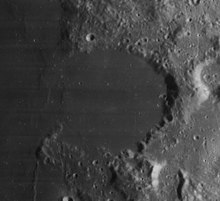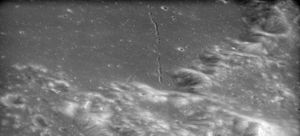
Cabannes is a lunar impact crater that lies in the southern hemisphere on the far side of the Moon. The rim has been worn by subsequent impacts, with a smaller crater overlying the southern rim. However the formation has not been significantly reshaped by nearby craters.

Chacornac is an irregular lunar impact crater attached to the southeast rim of the crater Posidonius. It lies just to the east of the Mare Serenitatis, and north of the crater Le Monnier. The crater is named after French astronomer Jean Chacornac.
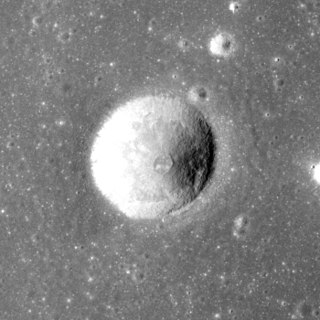
Borel is a tiny lunar impact crater located in the southeast part of Mare Serenitatis. It was named after French mathematician Émile Borel. To the northeast is the crater Le Monnier and to the southeast is the crater Abetti. Borel was previously identified as Le Monnier C.

Very is a small lunar impact crater located in the eastern part of Mare Serenitatis, to the west-southwest of Le Monnier. It lies upon a wrinkle ridge that runs to the north and south named Dorsa Smirnov. It was named after American astronomer Frank W. Very. The crater was previously known as Le Monnier B, a satellite crater of Le Monnier, before being renamed by the IAU in 1973.

Alter is a lunar impact crater that is located in the northern hemisphere on the far side of the Moon. It lies to the southwest of the larger crater Robertson, and to the east of Ohm.

Deslandres is the heavily worn and distorted remains of a lunar impact crater. It is located to the southeast of the Mare Nubium, in the rugged southern highlands of the Moon. In dimension it is the third-largest crater formation on the visible Moon, being beaten only by Clavius and by the 303-kilometer-diameter walled plain Bailly. The northern and eastern parts of the floor display a relatively level surface, but it is pock-marked with numerous craters. There is a small region of mare material, due to basaltic lava, along the eastern interior floor.

Boguslawsky is a lunar impact crater that is located near the southern lunar limb, to the northwest of the slightly larger crater Demonax, and southwest of the concentric crater Boussingault. Due to its location, this crater appears very oblong in shape because of foreshortening.

Cavalerius is a prominent lunar impact crater that lies on the western edge of the Oceanus Procellarum lunar mare on the west part of the visible Moon. It nearly joins the northern rim of Hevelius to the south.

Römer is a lunar impact crater that is located to the north of the Sinus Amoris in the northeast section of the Moon. It was named after Danish astronomer Ole Rømer. It lies in the southwestern part of the mountainous region named the Montes Taurus. It was unofficially named as Atatürk by astronomer Hugh Percy Wilkins in his lunar map, possibly due to the fact that the Montes Taurus are located in Turkey. To the west-northwest is the crater-bay Le Monnier, on the eastern edge of Mare Serenitatis.
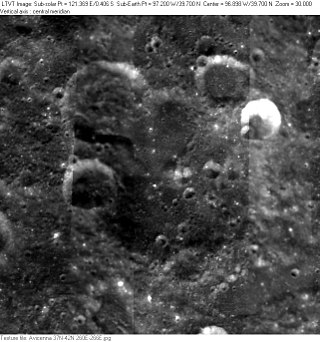
Avicenna is a lunar impact crater that lies on the far side of the Moon, just beyond the western limb on the northern rim of the Lorentz basin. It is named after the Persian polymath Avicenna. It lies to the north-northwest of the larger crater Nernst, and to the southeast of Bragg.

Fechner is a lunar impact crater that lies on the far side of the Moon's southern hemisphere, attached to the western rim of the large walled plain Planck. The eastern rim of Fechner intersects the Vallis Planck, a long, wide cleft in the surface that follows a course to the north-northwest. This valley intrudes into the southeastern rim of the crater, then continues northwards from the periphery of the northeast rim.

Becquerel is a lunar impact crater that lies in the northern hemisphere on the far side of the Moon. This is an ancient and heavily worn formation that is now little more than an irregular buri in the surface. The outer rim has been worn and reshaped until it forms a rugged, mountainous region around the flatter interior.

Boltzmann is an old lunar impact crater that is located along the southern limb of the Moon, in the vicinity of the south pole. At this location the crater is viewed from the side from Earth, and so not much detail can be seen. It is located to the north of the walled plain Drygalski, and to the west of the crater Le Gentil.

Chadwick is a lunar impact crater that lies on the far side of the Moon's surface, just beyond the southwestern limb. It is located to the northwest of the crater De Roy, and was previously designated De Roy X before being given its current name by the IAU. This region of the lunar surface lies at the southern end of the ejecta blanket that surrounds the Mare Orientale impact basin.

Coriolis is a lunar impact crater that is located on the far side of the Moon. The crater floor is bisected by the lunar equator, and it lies about three crater diameters northwest of the crater Daedalus.

Plana is a lunar impact crater that lies on the boundary between two small lunar mare areas, with Lacus Mortis to the north and the larger Lacus Somniorum on the southern side. It was named after Italian astronomer Giovanni Antonio Amedeo Plana. It is joined to the crater Mason to the east by a short stretch of rugged ground. Due north of Plana in the midst of the Lacus Mortis is the prominent crater Bürg.

Dove is a small lunar impact crater located in the rugged lunar highlands in the southeastern part of the Moon. It lies to the north of the prominent crater Pitiscus. The crater is named after Prussian physicist Heinrich Wilhelm Dove.
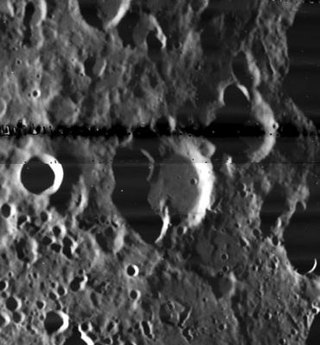
Douglass is a lunar impact crater on the far side of the Moon. It lies to the southwest of the crater Frost and south-southwest of the large walled plain Landau.

Dellinger is a lunar impact crater that is located on the Moon's far side. It is attached to the southern rim of the crater Pannekoek. To the southeast lies the crater Marconi, and to the southwest is Chauvenet.

Fleming is a large lunar impact crater that is located on the Moon's far side, and cannot be seen from the Earth. It lies about a crater diameter to the east-northeast of Hertz, and to the northwest of Lobachevskiy.
